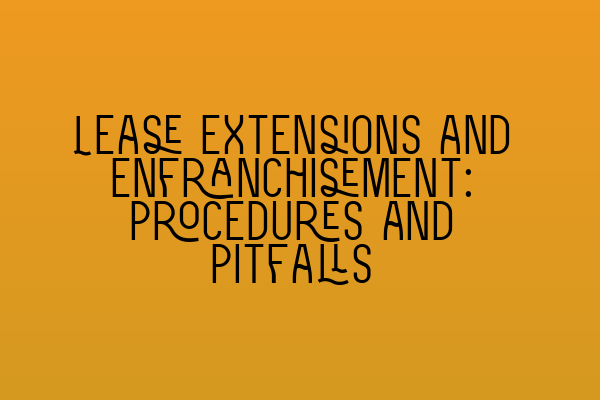Lease Extensions and Enfranchisement: Procedures and Pitfalls
Are you a leaseholder looking to extend your lease or perhaps even buy the freehold of your property? Understanding the procedures and potential pitfalls of lease extensions and enfranchisement is essential to protect your interests and make informed decisions. In this blog post, we will provide you with a comprehensive guide to lease extensions and enfranchisement, covering everything you need to know to navigate the process successfully.
What is a Lease Extension?
A lease extension allows a leaseholder to extend the length of their lease beyond its original term. As a leaseholder, it is crucial to be aware of the remaining years on your lease, as the value of your property tends to decrease as the lease term reduces. By extending the lease, you can enhance the value and marketability of your property.
There are two ways to extend a lease:
- Informal Lease Extension: This occurs when you negotiate directly with the freeholder to extend the lease. While this method can be quicker and less costly, it is generally recommended to seek professional advice to ensure the terms of the extension are fair.
- Statutory Lease Extension: Under the Leasehold Reform, Housing, and Urban Development Act 1993, leaseholders have the right to extend their lease by an additional 90 years. To exercise this statutory right, specific procedures must be followed, including serving a Section 42 Notice.
What is Enfranchisement?
Enfranchisement, on the other hand, refers to the process of leaseholders collectively purchasing the freehold of a property. This allows leaseholders to have greater control over the management of the building, potentially reducing service charges, and extending their own lease terms.
Enfranchisement requires leaseholders to form a company, known as a ‘Right to Manage’ company, which will be responsible for managing the building. To initiate the enfranchisement process, leaseholders must serve a Section 13 Notice on the freeholder.
Pitfalls to Avoid
While lease extensions and enfranchisement can be beneficial, there are several pitfalls that leaseholders must be aware of:
- Timelines: It is crucial to adhere to the strict timelines outlined in the legislation. Failure to meet deadlines can result in the loss of your rights and potential delays.
- Valuation: Determining the correct value for lease extensions and enfranchisement is critical. Seeking expert advice from a qualified valuer will ensure you don’t overpay or undervalue your property.
- Legal Requirements: The legal procedures involved in lease extensions and enfranchisement can be complex. Engaging an experienced property solicitor with expertise in this area is highly recommended to navigate the legal requirements properly.
- Service Charges: Before proceeding with lease extensions or enfranchisement, it is essential to assess the current and potential future service charges. Ensure the financial implications are carefully considered, and there are no hidden costs.
Conclusion
Lease extensions and enfranchisement offer valuable opportunities for leaseholders to protect their investments, increase property values, and have greater control over their homes. However, it is imperative to familiarize yourself with the procedures and potential pitfalls to make informed decisions.
If you require further advice or assistance with lease extensions or enfranchisement, please do not hesitate to contact our specialist property solicitors at SQE Property Law & Land Law.
Related Articles:
- Misrepresentation in Contracts: Unveiling Deceptive Practices
- SQE Contract Law: Analyzing Landmark Cases and Influential Judicial Decisions
- Understanding Contractual Capacity: Rights and Limitations
- Interactive SQE Mock Tests for Contract Law: Test Your Knowledge
- Join Our SQE Contract Law Webinars: Expert Insights and Guidance
